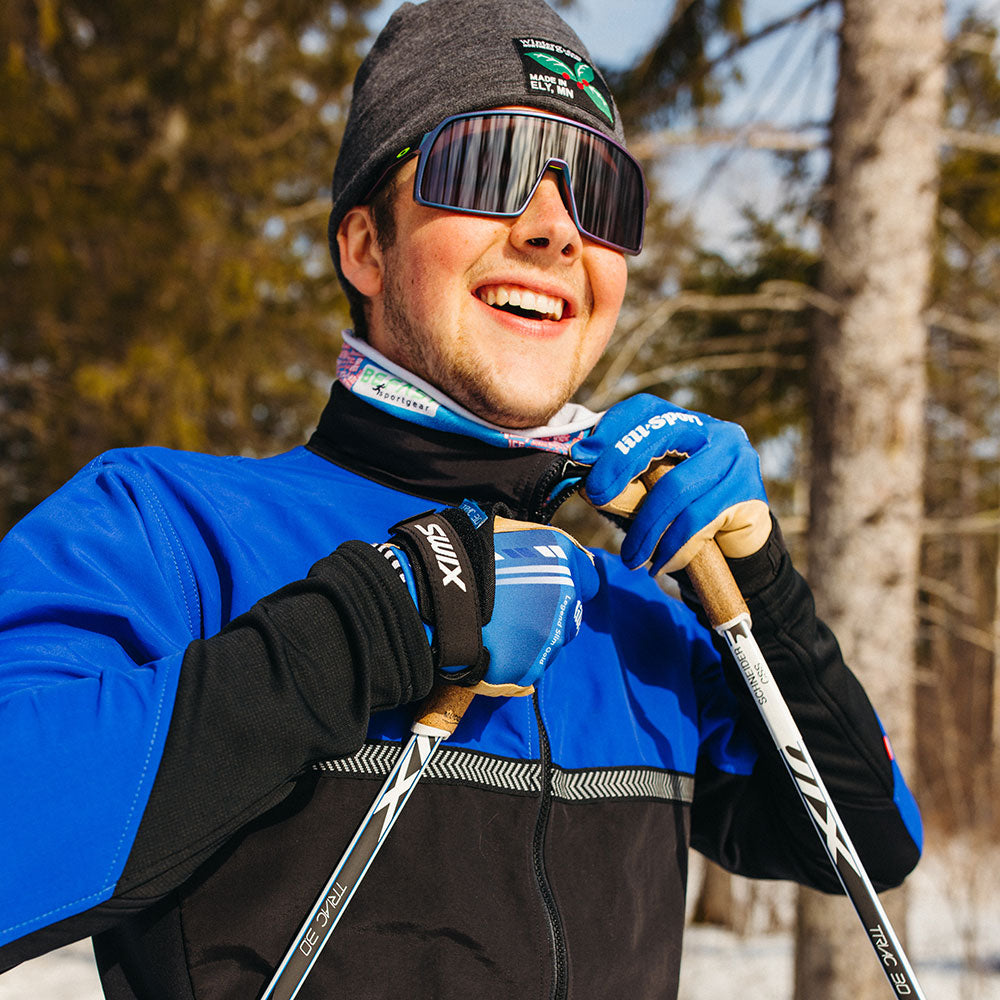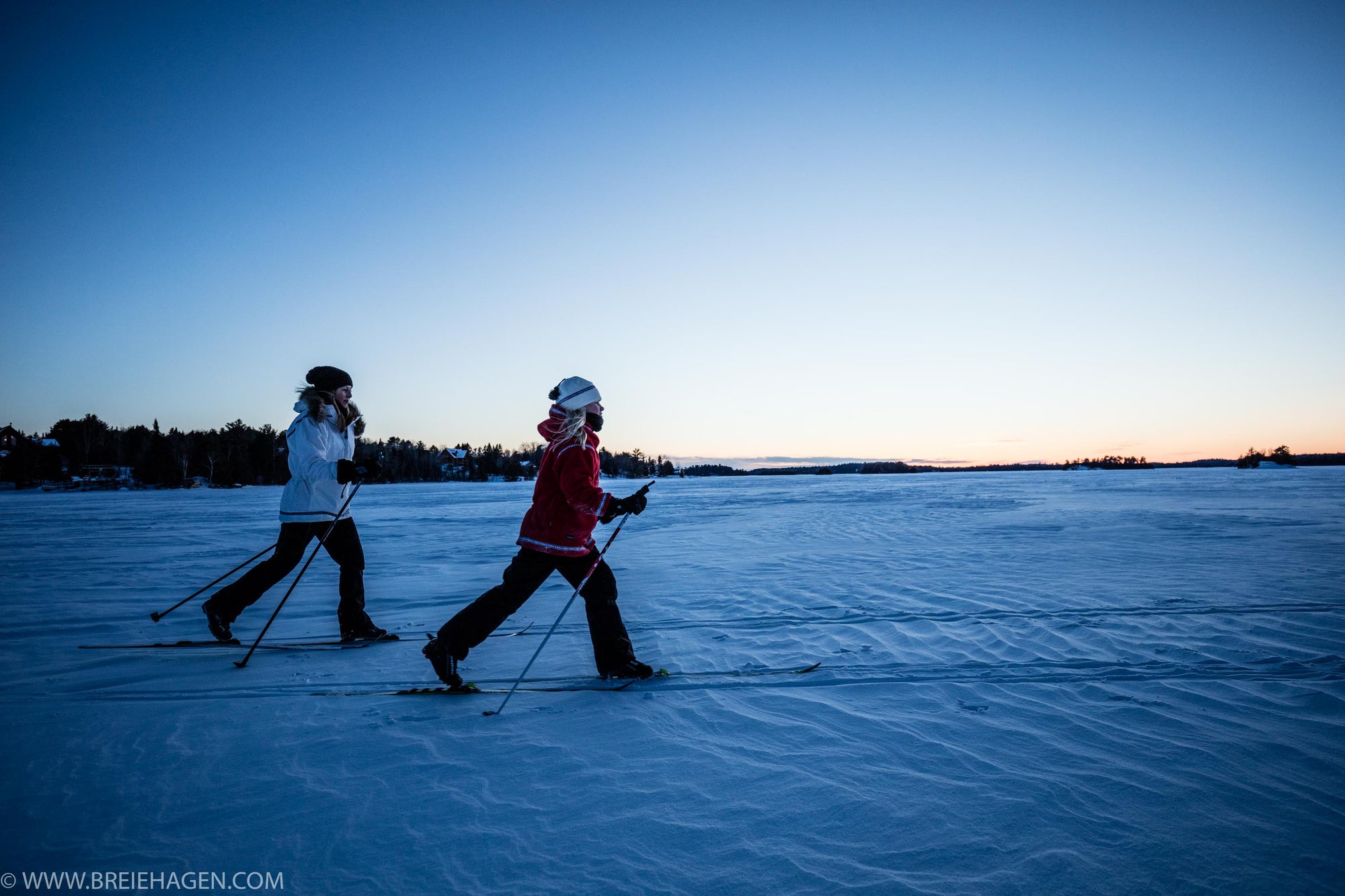You love skiing. You have a dog. You’ve watched some skijoring videos online. And now you’ve decided you want to learn more about skijoring, but you’re not sure where to start. Skijoring can be a blast, but there are some fundamentals that you want to get right before you head out to the trails with your dog and skis.

1) Make sure your dog is well-behaved in public
Your dog needs to be able to interact with other dogs, other people, and new situations without becoming aggressive, overly frightened, or too rambunctious. If your dog used to be well-mannered but hasn’t socialized much recently, gently reintroduce her to public spaces until you can be confident that she will behave well.
2) Assess whether your dog is physically capable
Your dog needs to be able to pull you without risk of injury to the dog. That means that your dog should be big enough that you don’t have to worry about crushing him. He also needs to be physically fit. If he’s overweight and rarely gets the chance to run, you’ll be risking a variety of injuries that can have serious consequences for the dog. In addition, an unfit dog is less likely to enjoy the experience of pulling and will be less likely to learn as a result.
3) Practice skiing
Trust me, you don’t want to combine learning to ski with learning to skijor. Trying to handle a dog while you have long plastic strips attached to your feet is hard enough when you’re a skilled skier. If you don’t have strong Nordic skiing skills, get out and practice until you feel confident stopping, turning, going up and down hills, and handling your poles gracefully.
4) Get the right equipment
In order to skijor, you should have a well-fitting harness for your dog, a padded belt for yourself, a bungee, a long-enough rope, and a quick release option for your system. That might seem like a lot, but if you’re on a budget you can use the DIY method to create everything except the harness.
The harness is the most important piece of equipment to get right, so it’s worth doing your research and then spending money on it. A well-fitting pulling harness is especially important. Don’t try to make your dog pull from her collar or from a front clip harness; your dog won’t want to pull if her harness chokes her or is otherwise uncomfortable. Pulling harnesses come in an incredible array of shapes and sizes, so if you’re uncertain how to fit your dog to a harness, take measurements, take some pictures, and consult an expert. Most stores that sell harnesses and similar equipment allow you to bring your dog inside for sizing.
Once you have a harness, you can easily buy a skijor package with the rest of the equipment. If you’re on a budget, it’s easy to make your own. My personal skijor equipment includes the padded waist belt from an old backpack, a thick rubber bungee from the hardware store as a shock absorber, and a very long leash that I attach to the front of the bungee. My system can be quickly released by unbuckling the waist belt, so I can detach myself from my dog in an emergency.
5) Teach your dog to pull before you’re on skis
Once you have the equipment, teach your dog to pull in harness before you go skiing. Take your dog for a jog or walk with the dog in harness, and make sure you’re only moving forward when they’re pulling. It’s a lot easier to teach when you don’t have to worry about your skis hitting your dog if you get too close. There are plenty of online resources that explain how to teach your dog to pull.
6) Be a spectator at a skijor race or a dog sled race
You can learn a lot by watching others. Races (such as Ely’s Wolftrack Classic) are fun to attend, inspiring, and will expose you to a lot of different types of equipment and dog handling styles. Some athletes will teach you best practices, while others will demonstrate what you don’t want to do. Be aware that spectators aren’t allowed to bring their own dogs, so leave the pup at home this time.
7) Pick up your dog’s poop
If you’re on public trails, remember to bring some plastic bags. Leaving messes gives all of us a bad name, and can lead to dogs getting banned from skiing areas that previously allowed it.
8) Wear a helmet and other protective gear as needed
Head trauma is no joke, and skijoring can be unpredictable. You might think you’ve got everything under control, but the situation can change quickly if a deer bolts right in front of your dog and you get pulled straight through a dense forest at a sprint. Even dogs that don’t seem incredibly strong might surprise you when an exciting situation presents itself. In addition, even if there aren’t trees to hit, the ground can be pretty hard if you go over a bump that stops your skis while the rest of your body continues to be pulled forward. Icy patches also present special challenges – I’ve learned the hard way to wear knee and elbow padding when conditions might be marginal.
9) Remember to laugh and have fun!
You and your goofy mutt might not become world-class skijor champions, but you can still have fun together. Learning to skijoring can create all kinds of entertaining situations, and approaching it with a sense of humor will help you enjoy it more. Your dog will pick up on your mood, so being cheerful and enjoying yourself also augments your success by encouraging your dog to have fun too. Good luck!
Author: Saeward Schillaci
Saeward Schillaci is a professional writer and editor. She is the founder of Northwoods Editing, which specializes in helping businesses create quality written content. Currently, Saeward lives on an off-grid property near Isabella, MN with six other people, sixty-two sled dogs, ten chickens, two cats, and some wild star-nosed moles. In her spare time, she enjoys canoeing, climbing, creative writing, skiing, dog sledding, and playing with puppies.





3 comments
Simone
I read about my state’s annual Skijoring event this morning and was directed to this site.
Amazingly, [you] provide a link to www.clickertraining.com! – The BEST WEBSITE FOR TRAINING dogs AND cats, WITHOUT PUNISHMENT.
It is the only effective way to bond with your animals and see results.
After over 40 years of LOVING and working with cats and dogs labeled “unable to be adopted,” special needs, have been returned (several times), or in euthanasia status, I have never failed my animals in their rehabilitation. Because of Positive Reinforcement, my animals have never failed me.
I always start with clicker training with a tiny food reward, eventually removing the food and replacing it with “click and cuddles.”
All animals love to have a job. Giving them one, with positive reinforcement, becomes a lifetime of happiness for your animal family and you.
I read about my state’s annual Skijoring event this morning and was directed to this site.
Amazingly, [you] provide a link to www.clickertraining.com! – The BEST WEBSITE FOR TRAINING dogs AND cats, WITHOUT PUNISHMENT.
It is the only effective way to bond with your animals and see results.
After over 40 years of LOVING and working with cats and dogs labeled “unable to be adopted,” special needs, have been returned (several times), or in euthanasia status, I have never failed my animals in their rehabilitation. Because of Positive Reinforcement, my animals have never failed me.
I always start with clicker training with a tiny food reward, eventually removing the food and replacing it with “click and cuddles.”
All animals love to have a job. Giving them one, with positive reinforcement, becomes a lifetime of happiness for your animal family and you.
Karen D. Happnie
Would love to try this with my WPG. are there places in Northeast Ohio to do tnis?
Would love to try this with my WPG. are there places in Northeast Ohio to do tnis?
Nadine Livingston
Thank you so much for this article! I rescued a 5week old puppy just as COVID hit and she’s now 9 months old and super active! Dakota is a shepherd/husky/mastiff mix who loves the water, snow, well, just about anything! She just finished agility training and her trainer/adopted aunt recommended we try skijooring (which she does with a few of her dogs)
My furbaby is a puppy who loves to have tasks/work and pull. So as I was researching and came across your advice. LOVE it! And really looking forward to seeing if this is another thing we can enjoy together. We’re in Canada and have already had a few snow falls so I’m going to get started with training.
Thank you again, this is great!
Thank you so much for this article! I rescued a 5week old puppy just as COVID hit and she’s now 9 months old and super active! Dakota is a shepherd/husky/mastiff mix who loves the water, snow, well, just about anything! She just finished agility training and her trainer/adopted aunt recommended we try skijooring (which she does with a few of her dogs)
My furbaby is a puppy who loves to have tasks/work and pull. So as I was researching and came across your advice. LOVE it! And really looking forward to seeing if this is another thing we can enjoy together. We’re in Canada and have already had a few snow falls so I’m going to get started with training.
Thank you again, this is great!